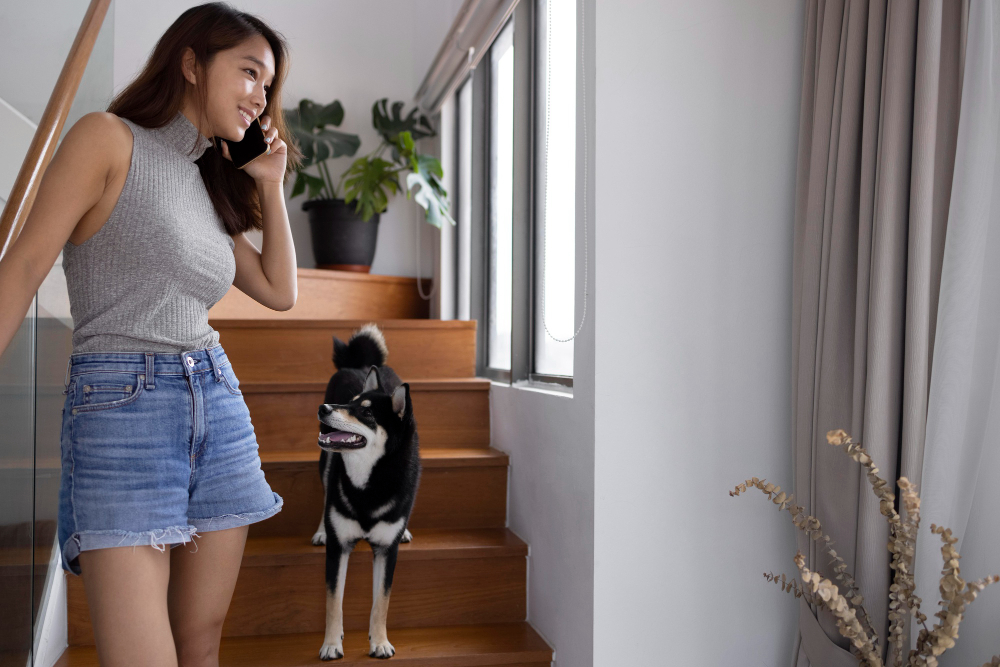I used to dread the sound of the doorbell. Not because I was expecting bad news, but because of Scout—our spirited mutt with a bark that could wake the dead. The moment the bell rang, Scout would launch into a frenzy: barking, racing to the door, jumping at the window. If you’ve ever had guests waiting awkwardly on your porch while your dog staged a full-blown meltdown inside, you know exactly what I mean.
Scout wasn’t trying to be bad. She just didn’t know what else to do with that sudden burst of adrenaline. The doorbell was her cue: something exciting (or terrifying!) was about to happen. But over time, with patience, structure, and a few tricks I picked up along the way, Scout went from chaos coordinator to calm greeter.
Here’s how you can help your dog do the same.
Contents
Why Dogs Freak Out at the Doorbell
To your dog, the doorbell is not just a sound—it’s a signal. It might mean visitors, danger, or something unknown. For high-alert pups like Scout, it kicks their arousal into overdrive. Combine this with natural watchdog instincts, and you’ve got a recipe for high-volume chaos.
Certain breeds, especially herding or guarding types, are hardwired to alert their humans to anything suspicious. Even dogs with minimal guarding instinct can get overly excited simply because they associate the doorbell with action, attention, or even getting leashed up for a walk.
Step-by-Step: Teaching Calm Doorbell Behavior
Step 1: Set the Scene for Calm
Before we tackled the doorbell itself, I worked on lowering Scout’s overall arousal level at home. That meant more enrichment and structure during the day (think puzzle feeders and decompression walks), and setting up a calm space when we expected visitors.
Scout had her own “place” near the entrance: a cozy mat next to her favorite toy, and yes—she rocked her pet embroidered sweatshirt like a pro. A visible, tactile spot helped her learn where to go during the training.
Using custom pet pajamas or designated gear can help signal that this is a different type of moment—not a free-for-all bark fest.
Step 2: Desensitize the Bell
We recorded the doorbell on our phone and started playing it at low volume throughout the day. Every time it dinged, Scout got a piece of high-value mounds pet food or a game with her squeaky toy.
The goal? Teach her that the bell doesn’t predict chaos, it predicts cheese.
We even introduced variations: ringing the bell from outside, having a friend tap the glass, and eventually real people visiting. At each stage, we reinforced with something amazing—a strategy that works great even with dogs who have pet insurance mn or behavioral support needs.
Step 3: Train an Incompatible Behavior
Instead of just teaching Scout not to bark, we gave her a job: go to your mat when the doorbell rings.
We shaped this gradually:
- Ring = look at me (treat!)
- Ring = go to mat (treat!)
- Ring = go to mat and stay (treat! then release!)
Repetition is key here. We used a lot of lucky pet-style encouragement (cheerful voice, big rewards). And we avoided using the bell when we couldn’t reinforce.
Step 4: Add Real-World Chaos
Once Scout could handle fake guests, we upped the ante: real guests, moving around, talking, and bringing smells from the outside world.
At this point, we also started reinforcing with variable rewards. Sometimes it was a treat. Sometimes a game. Sometimes a walk. Using things like lupine pet collars or pet point rewards helped keep Scout guessing, which kept her engaged.
We also practiced recall between doorbell drills. It became a game, not a test. Our friends loved helping (and petting her when she succeeded).
Step 5: Reinforce Like You Mean It
Every time Scout stayed calm, she got something meaningful. For high-arousal dogs, random reinforcement isn’t enough. We brought out the best: axis pet insurance-covered treats, her favorite tug toy, even frozen peanut butter bones.
We avoided correction-based methods. The goal wasn’t to punish the barking—it was to replace it.

What If Your Dog Still Struggles?
If your pup is still reacting wildly, it may be that the training pace is too fast. Go back a step. Simplify the environment. Reinforce more heavily.
Sometimes, even with a solid plan, you might need extra help. Trainers can guide you, and if you have coverage like usaa pet insurance, pet insurance ct, or liberty mutual pet insurance, you may even be reimbursed for behavior consultations.
Just remember, there is no “too slow” when it comes to counter-conditioning. There is only progress, at your dog’s pace.
Safety Matters More Than You Think
Teaching your dog to stay calm at the door isn’t just polite—it’s also a safety issue. Dogs who bolt out the door can get lost, hurt, or worse. We always make sure Scout wears ID and has home again pet recovery microchip support. If your dog ever slips out, services like these can save lives.
Plus, living with a calm dog makes it easier to travel. Whether it’s staying at pet friendly apartments or checking into pet friendly hotels in Colorado or Oregon, a doorbell-trained dog is welcome more places.
Final Thoughts: Calm Is a Trainable Skill
Scout didn’t learn this overnight. It took time, consistency, and a lot of cheddar. But now when the bell rings, she might lift her head, stretch, and wander to her mat like a pro.
And you know what? It’s not just that life is easier now. It’s that I can see Scout thinking through it. Choosing calm. And that, my friend, is the magic of training.
So grab some pet first insurance peace of mind, pick up those custom pet pajamas, and give it a go. Your future self—and your neighbors—will thank you.
Keywords naturally included: mounds pet food, liberty mutual pet insurance, lupine pet collars, pet insurance ct, pet insurance oregon, pet insurance colorado, pet insurance michigan, lucky pet, usaa pet insurance, custom pet pajamas, pet first insurance, pet insurance mn, axis pet insurance, pet embroidered sweatshirt, pet point









